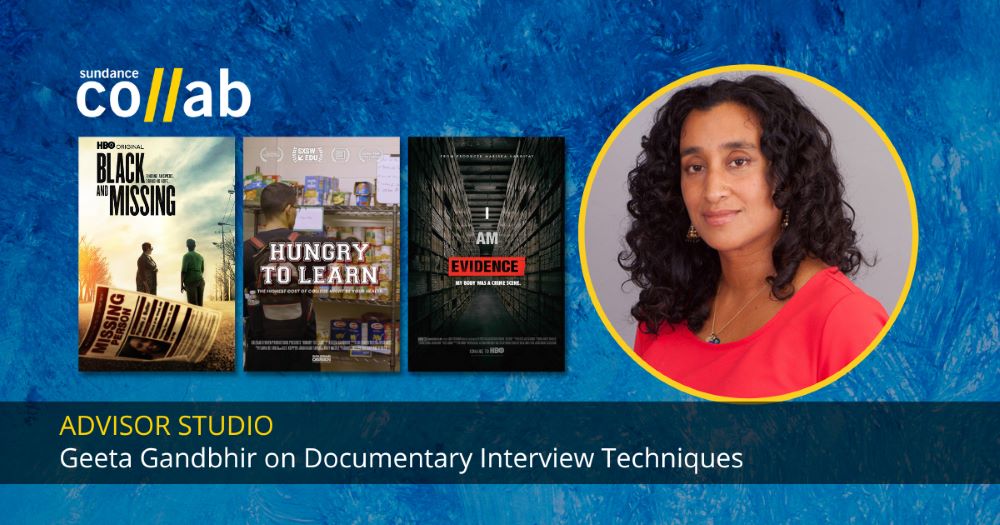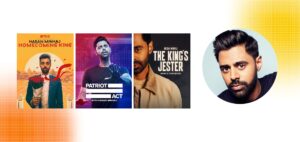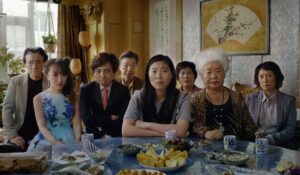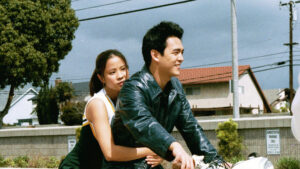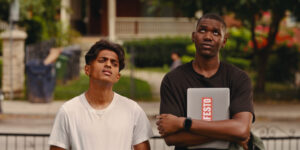Editor’s note: The Sundance Collab event Advisor Studio Series: Geeta Gandbhir on Documentary Interview Techniques originally took place on May 31, 2022. This AAPI Heritage Month, we’re revisiting sessions like this one as we spotlight Asian American and Pacific Islander voices in independent film. You can watch in its entirety as part of your Collab membership.
By Vanessa Zimmer
While the script drives the action in a narrative film, interviews are the skeleton of a documentary, says award-winning director, editor, and producer Geeta Gandbhir.
“I lay out my interview bites first, because those are the necessary bones of the storytelling, and then you build everything else around them,” the filmmaker explained last spring in a Sundance Collab Advisor Studio Series on interviewing techniques for documentaries.
That principle elevates interview sessions to a position of critical importance in filming a truthful and compelling documentary.
Among Gandbhir’s works are a powerful documentary about sexual assault and the backlog of rape kits, I Am Evidence, co-directed with Trish Adlesic, and Armed With Faith, co-directed with Asad Faruqi, which followed a bomb disposal unit in Pakistan pitted against Afghan terrorists. Both works won Emmys.
Following are some of the veteran filmmaker’s recommendations for conducting interviews.
Research thoroughly.
“For every single person I interview in a film, I make sure that my team and I put together their biography, and we do sort of a deep dive,” Gandbhir says. If the individual has written a book, for example, read the book. Gather all the material you can so that you can ask informed questions.
Do pre-interviews.
Get acquainted before the actual filmed interview to make the interviewee as comfortable as possible. Transparency is key. “You explain to them what the process looks like,” she says. “You explain to them what you’re doing, why you’re doing it, what the purpose of the film is, what your motivation is … to create that trust.”
Take steps to protect those who have been traumatized.
Individuals conducting interviews with people who have experienced trauma should be trained by professionals “so we learn how to ask questions appropriately.” And interviews should be done in a safe place, perhaps the interviewee’s home if that’s where they feel the safest — or elsewhere if they are uncomfortable exposing their home or if their neighborhood is where they were attacked.
Take breaks from the interview, perhaps returning on another day for an additional session. In no case should any interview proceed for more than two hours; beyond that is too exhausting.
“The idea of working with survivors has taught me, in many ways, how I feel everyone should be treated,” Gandbhir says. “When you do an interview, there is such a vulnerability on the other side of the camera. … And they’re being so incredibly generous with their time.”
Decide which member of the team should conduct each interview.
Ideally, the interviewer should not be a person who makes the interviewee feel threatened. “My tactic is to be as disarming as possible.”
Never go into an interview with a rigid viewpoint.
Resolve to do justice to that individual’s story, regardless of whether you agree with the person’s politics or opinions.
“When you come at people in a noncombative way, you get more out of them, they’re willing to open up more.” Especially when interviewing a person who might be on the defensive, allow them to explain their side on camera.
If they refuse to answer a question, put that on camera as well. At the very least, that shows you’ve done your job.
It’s no different from good journalism, Gandbhir says. “If one side tells you it’s raining and the other side tells you it’s not raining, it’s your job to go outside and figure out if it’s raining.”
Approach every interview with deep interest.
Gandbhir says she genuinely enjoys people. “Every interview for me is a class; it’s like I’m in class and getting to know someone and understanding their story, so I approach it with deep interest.”
Start off with a warmup — chat about pets, perhaps, or where they grew up. Keep a conversational tone as you begin asking your questions.
Listen!
If the interviewee answers a question on your list while addressing another issue, cross the question off your list. Don’t subject them to repeating themselves.
Connect your questions in a logical and natural way. Show that you can be trusted to do justice to their story. “Every single person deserves that time and care.”
Ask the difficult questions last.
Especially if you suspect a question might make a person combative, save that issue for the end of the conversation. Gather the less volatile, but important, material first.
Sundance Collab is a global digital space for independent filmmakers. To learn more tips from Geeta Gandbhir, such as when to show filmed interviews to participants, click here to view the Advisor Studio Series session in its entirety.




